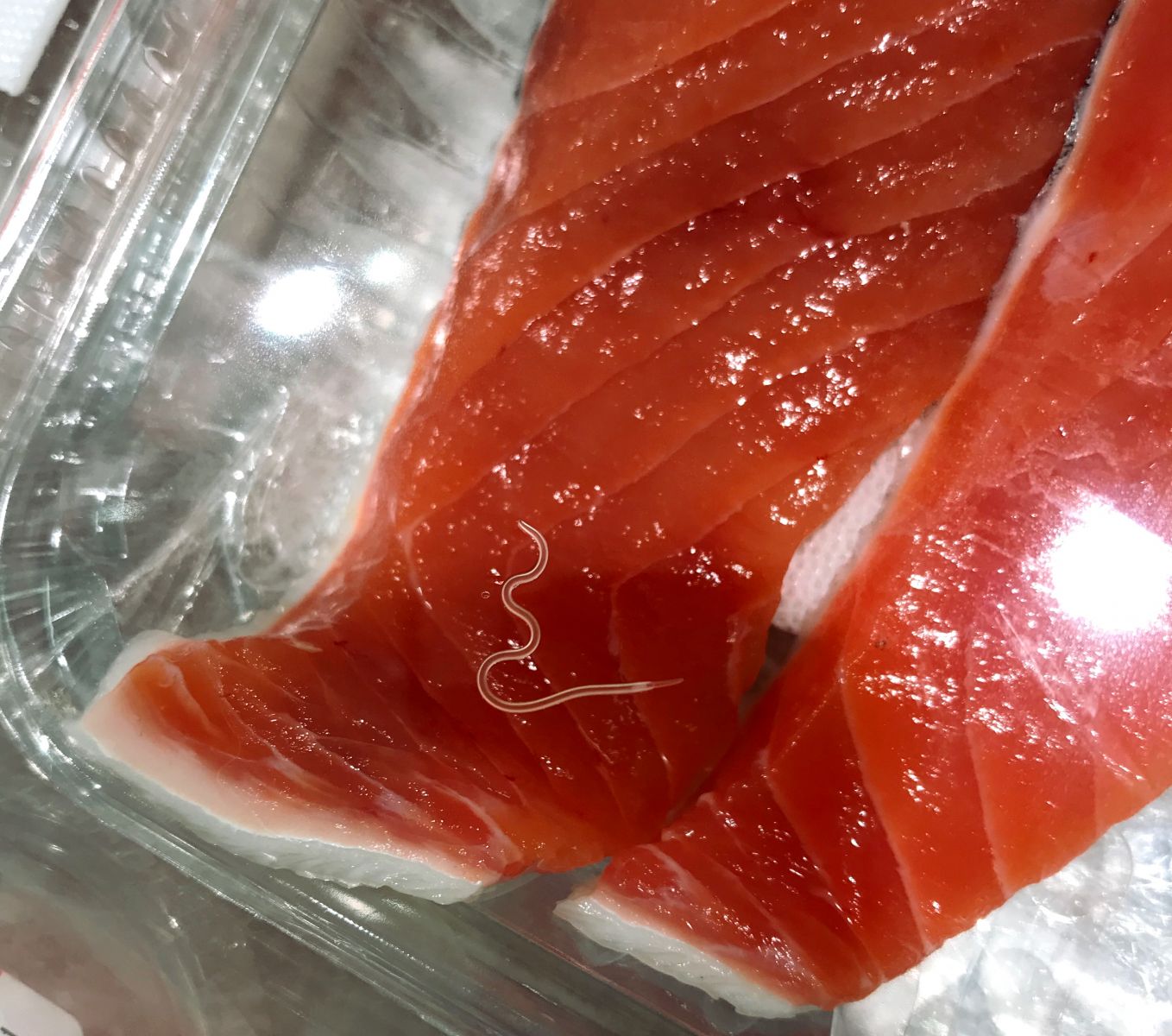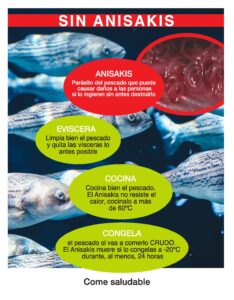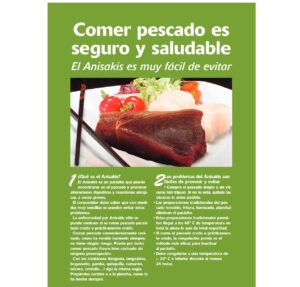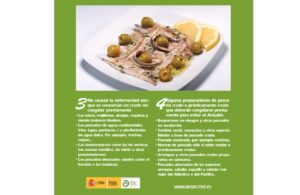
WARNING! Worms in fish we caught. What to do ?
Food safety: Anisakis, the fish worm

Anisakis Simplex is a nematode(worm); a parasite that infects marine mammals (whales, dolphins, seals, etc.) and large fish, in which it develops until it reaches its adult form. They have a small size and an almost transparent whitish color, which causes them to go unnoticed in many occasions, so they can be easily ingested without previous observation.
Which fish may contain Anisakis?
As we saw in the introduction, the most common is a worm that infects fish, normally we will see it in cod, cod, sardine, anchovy, herring, salmon, pollock, hake, whiting, mackerel, bonito, horse mackerel, among others. It also affects cephalopods(squid, octopus, cuttlefish, etc.).
The amount of anisakis varies depending on the place of capture and the time at which the fish is eviscerated or gutted. Thus, fish caught offshore that are quickly eviscerated have fewer parasites than fish caught on shore.
¿What diseases caused by Anisaki?
Once the parasite larvae are ingested, they can cause two different types of pathologies: anisakiasis or anisakidosis and anisakis allergy.
1.Anisakiasis or anisakidosis
This disease is acquired by the consumption of live anisakis larvae due to the ingestion of raw, smoked, salted, pickled, marinated or undercooked, microwaved or grilled fish.
The clinical picture may be mild or more or less severe. Larvae mainly affect the gastrointestinal tract and survive the different digestive secretions. They can become embedded and cause inflammation or, in the most severe cases, perforate the stomach and intestine or migrate to other tissues and organs.
The gastric form presents with abdominal pain, with or without nausea, vomiting and diarrhea, which may resemble the manifestations of other diseases such as appendicitis, ileitis (inflammation of the portion of the small intestine called ileum), gastric ulcer, intestinal obstruction and even abdominal tumors.
Cases of joint involvement and involvement of other organs (lung, liver, pancreas and spleen) have also been found.
A good medical history is essential in the diagnosis of the disease, since the vast majority of patients report having eaten fish in the previous 48-72 hours. Endoscopic techniques (gastroendoscopy or colonoscopy) allow the larvae to be seen and removed, although in more severe cases surgery may be necessary.
- Anisakis allergy
People allergic to this parasite show various symptoms after ingestion of infested fish. These symptoms vary from simple urticaria (skin rash) to angioedema, which is characterized by the appearance of large welts on the skin surface, especially around the eyes and lips, and may also affect the hands, feet and throat. The most severe cases are associated with 'anaphylactic shock' requiring hospital admission, and may or may not be accompanied by the gastrointestinal symptoms mentioned above.
Applicable regulations in Spain
Different awareness materials are available at AECOSAN. For example, the ANISAKIS POSTER that can be pasted in food establishments. Also available in format ANISAKIS TRIPTYCH.
In relation to the allergy explained in the previous section, it is worth mentioning the Report of the Scientific Committee of the Spanish Agency of Consumption, Food Safety and Nutrition (AECOSAN) in relation to the allergy to Anisakis, you can read or download it here LINK.
How is Anisaki transmitted?
The infection is acquired by humans accidentally, usually after ingestion of fish containing the tertiary larvae of the parasite.
The life cycle of Anisakis is as follows: adult parasites inhabit the intestine of marine mammals such as whales and dolphins, and eliminate the eggs with their feces. The eggs release larvae into the water which are ingested by crustaceans where they develop into the tertiary form. The crustaceans, in turn, are ingested by fish, in whose muscles the larvae settle. Transmission to humans occurs by ingestion of contaminated infected fish, with humans becoming the final host. The life cycle ends when marine mammals ingest contaminated fish and the parasite transforms into an adult in their intestine and begins to eliminate the eggs in the feces. No human-to-human transmission has been demonstrated.
What preventive measures should be taken?
Individuals can take the following steps to prevent anisaki contamination:
- Avoid fish viscera, as they contain larvae that migrate to muscle tissue.
- Avoid consumption of raw or undercooked fish if it has not been previously frozen (sushi, anchovies, grilled fish, smoked fish, salted fish, etc.).
- Report allergy or intolerance if eating fish outside the home.
- Avoid cross contamination with utensils used in the kitchen.
- Freezing: It is the safest treatment for the inactivation of larvae. It is advisable to previously freeze the product at a temperature below -20º C for at least 24 hours.
- Adequate heat treatment: It has been demonstrated that larvae are inactivated when subjected to heat treatment for 5 to 10 min, reaching 60º C in the center of the product. Therefore, the safe culinary techniques are:
- Boiled: it reaches temperatures above 90º C.
- Fried: it reaches temperatures above 170º C.
- Iron and microwave: Ensure that the temperature in the center is higher than 60º C. Preferably freeze before using these techniques.
Obligations for the hospitality sector
In restaurants, bars, hotels, stores, etc., the following obligations must be complied with:
- Ensure that fishery products for raw consumption or those which, due to their processing, have not been heated above 60ºC in the center of the product, have been frozen at -20ºC for at least 24 hours.
- Elaborate a informative posterto hang in the establishment or attached to the food menu in which it is reflected:
- In compliance with Royal Decree 1420/2006, of December 1, on the prevention of anisakis parasitosis in fish products supplied by establishments that serve food to final consumers or collectivities, this establishment guarantees that the fish products for raw consumption or those that, due to their preparation process, have not been heated above 60º C in the center of the product, have been frozen at -20º C for at least 24 hours.
https://www.prevensystem.com/internacional/412/noticia-seguridad-alimentaria-anisakis-el-gusano-del-pescado.html Noticia original.


At AZ Trading we work every day to satisfy the needs of our customers through the highest quality, innovation and design of our products.
We are distributors of sport fishing equipment, accessories and clothing from the best brands in Japan, Australia, New Zealand, USA, ...
Our headquarters are in Alicante, with offices in Barcelona (Spain) and we have a distribution network in several European countries.
Kind regards,
AZ Trading.
